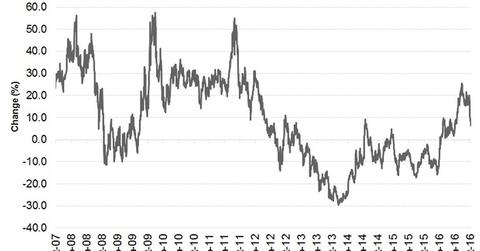Gold and Gold Miners: Analyzing Recent Performance
Gold bullion ended September at $1,315.75 per ounce for a 0.5% gain while gold stocks experienced more positive returns. The NYSE Arca Gold Miners Index[1. NYSE Arca Gold Miners Index (GDMNTR) is a modified market capitalization-weighted index comprised of publicly traded companies involved primarily in the mining for gold] (GDMNTR) posted a 3.8% gain, while […]
Oct. 20 2016, Updated 12:04 p.m. ET

Gold bullion ended September at $1,315.75 per ounce for a 0.5% gain while gold stocks experienced more positive returns. The NYSE Arca Gold Miners Index[1. NYSE Arca Gold Miners Index (GDMNTR) is a modified market capitalization-weighted index comprised of publicly traded companies involved primarily in the mining for gold] (GDMNTR) posted a 3.8% gain, while the MVIS™ Junior Gold Miners Index[2. MVIS Global Junior Gold Miners Index (MVGDXJTR) is a rules-based, modified market capitalization-weighted, float adjusted index comprised of a global universe of publicly traded small- and medium-capitalization companies that generate at least 50% of their revenues from gold and/or silver mining, hold real property that has the potential to produce at least 50% of the company’s revenue from gold or silver mining when developed, or primarily invest in gold or silver] (MVGDXJTR) advanced 5.8%.
Market Realist – Gold performance
Gold continued to strengthen in the second quarter, rising 7.4%—although this rise was slower than the first-quarter pace of 11.3%. The macro environment remained supportive in the second quarter, as expected. Elevated macro and political uncertainty boosted safe-haven demand, especially after the Brexit shock. However, gold’s demand has been sluggish in the third quarter, and it may reverse in the fourth quarter once macro fears diminish and the Fed resets market expectations about rates.
Several years ago, when gold prices were marching toward their near-$1,900 peaks, the stocks of gold mining (GDXJ) (GDX) companies did well, but they didn’t climb as much as gold ETFs. Between January 1, 2009, and September 2, 2011, when gold reached its all-time high, the popular SPDR Gold Trust ETF (GLD) jumped 114% while the NYSE ARCA Gold Miners (GDMNTR) Index rose about 94%. Since September 2011, gold prices have plunged about 24% while many mining stocks have fallen even further as of September 30, 2016.
Gold and silver (SLV) have become increasingly attractive in a negative interest rate world. A third of global government bonds (BND) (AGG) are trading at a negative nominal yield. However, a rise in the federal funds rate could impact prices negatively—if yields climb, people may be more inclined to buy bonds (SJNK) (LQD) than gold. Since gold ETF holdings and speculative net long positions on Comex have jumped year-to-date, selling pressure could induce a fast fall in gold prices later this year and early in 2017. However, jewelry demand will likely rise in India (EPI) (PIN) due to the festive season, which includes Diwali.
In the next parts of this series, we’ll discuss key takeaways from the 2016 precious metals summit.
